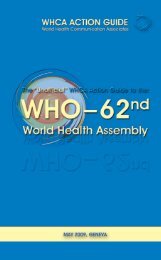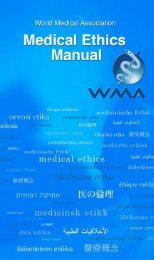the basics - World Health Communication Associates
the basics - World Health Communication Associates
the basics - World Health Communication Associates
- No tags were found...
Create successful ePaper yourself
Turn your PDF publications into a flip-book with our unique Google optimized e-Paper software.
4.3 MEDIA MARKETPLACESFor many people media marketplaces—including print, radio, television, internet,mobile phones and public advertising spaces—are a main source of healthinformation. These marketplaces shape people’s health perceptions, behavioursand choices even though <strong>the</strong>y often contain information of variable quality thatcan be more confusing than helpful. Separating fact from fiction requires somewell-developed health literacy skills. National health information services, like <strong>the</strong>NHS Direct in <strong>the</strong> UK (http://www.nhsdirect.nhs.uk/), can help people decipher <strong>the</strong>variety of health information. Some quality standards and certifications, such as <strong>the</strong><strong>Health</strong> On <strong>the</strong> Net (HON) standards (http://www.hon.ch/HONcode/Conduct.html),have been developed for quality control of health web pages but have not yet beenapplied globally and have not been shown to make websites easier to understand.Commercial and political interests often dominate <strong>the</strong> media marketplaces.Industries such as tobacco, alcohol and fast food companies use sophisticatedcommunication techniques which glamorise and promote unhealthy products andlifestyles. Recognising and countering <strong>the</strong>se negative health messages requireliteracy skills to distinguish credible, reliable and independent information fromsales-driven product marketing and advertising.InterventionsIncreasingly, public health advocates and educators are using a wide range oftechnologies, media and social marketing approaches to get independent evidencebasedinformation to stand out and shape people’s perceptions, choices andbehaviours.People need credible, reliable, accessible and understandable information sothat <strong>the</strong>y can avoid risky behaviours. This might be about lifestyle choices, mentalwellbeing, <strong>the</strong> control of infectious diseases and environmental threats to health.Such information can help raise people’s understanding of risks, enable <strong>the</strong>m tomake healthy choices and counteract <strong>the</strong> negative influences of some industries.Interventions can also be used to shape <strong>the</strong> development of policies and structuresthat can protect health—for example smoking bans in public places.This domain of health literacy activity has been a very active interventionarea in all countries. Public information approaches which support health literacy arethought to provide a necessary basis for:· informed decision-makingSECTION 4: WHAT CAN WE DO TO STRENGTHEN HEALTH LITERACY? 47






